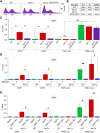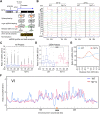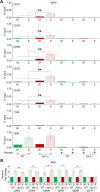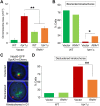R-loops at centromeric chromatin contribute to defects in kinetochore integrity and chromosomal instability in budding yeast
- PMID: 33147102
- PMCID: PMC8098821
- DOI: 10.1091/mbc.E20-06-0379
R-loops at centromeric chromatin contribute to defects in kinetochore integrity and chromosomal instability in budding yeast
Abstract
R-loops, the byproduct of DNA-RNA hybridization and the displaced single-stranded DNA (ssDNA), have been identified in bacteria, yeasts, and other eukaryotic organisms. The persistent presence of R-loops contributes to defects in DNA replication and repair, gene expression, and genomic integrity. R-loops have not been detected at centromeric (CEN) chromatin in wild-type budding yeast. Here we used an hpr1∆ strain that accumulates R-loops to investigate the consequences of R-loops at CEN chromatin and chromosome segregation. We show that Hpr1 interacts with the CEN-histone H3 variant, Cse4, and prevents the accumulation of R-loops at CEN chromatin for chromosomal stability. DNA-RNA immunoprecipitation (DRIP) analysis showed an accumulation of R-loops at CEN chromatin that was reduced by overexpression of RNH1 in hpr1∆ strains. Increased levels of ssDNA, reduced levels of Cse4 and its assembly factor Scm3, and mislocalization of histone H3 at CEN chromatin were observed in hpr1∆ strains. We determined that accumulation of R-loops at CEN chromatin contributes to defects in kinetochore biorientation and chromosomal instability (CIN) and these phenotypes are suppressed by RNH1 overexpression in hpr1∆ strains. In summary, our studies provide mechanistic insights into how accumulation of R-loops at CEN contributes to defects in kinetochore integrity and CIN.
Figures








Similar articles
-
Budding yeast CENP-ACse4 interacts with the N-terminus of Sgo1 and regulates its association with centromeric chromatin.Cell Cycle. 2018;17(1):11-23. doi: 10.1080/15384101.2017.1380129. Epub 2018 Jan 2. Cell Cycle. 2018. PMID: 28980861 Free PMC article.
-
Cell cycle-dependent association of polo kinase Cdc5 with CENP-A contributes to faithful chromosome segregation in budding yeast.Mol Biol Cell. 2019 Apr 1;30(8):1020-1036. doi: 10.1091/mbc.E18-09-0584. Epub 2019 Feb 6. Mol Biol Cell. 2019. PMID: 30726152 Free PMC article.
-
Pat1 protects centromere-specific histone H3 variant Cse4 from Psh1-mediated ubiquitination.Mol Biol Cell. 2015 Jun 1;26(11):2067-79. doi: 10.1091/mbc.E14-08-1335. Epub 2015 Apr 1. Mol Biol Cell. 2015. PMID: 25833709 Free PMC article.
-
Insights into assembly and regulation of centromeric chromatin in Saccharomyces cerevisiae.Biochim Biophys Acta. 2012 Jul;1819(7):776-83. doi: 10.1016/j.bbagrm.2012.02.008. Epub 2012 Feb 16. Biochim Biophys Acta. 2012. PMID: 22366340 Free PMC article. Review.
-
Protein kinases in mitotic phosphorylation of budding yeast CENP-A.Curr Genet. 2019 Dec;65(6):1325-1332. doi: 10.1007/s00294-019-00997-5. Epub 2019 May 22. Curr Genet. 2019. PMID: 31119371 Review.
Cited by
-
Dynamic Change of R-Loop Implicates in the Regulation of Zygotic Genome Activation in Mouse.Int J Mol Sci. 2022 Nov 18;23(22):14345. doi: 10.3390/ijms232214345. Int J Mol Sci. 2022. PMID: 36430821 Free PMC article.
-
ZBTB24 is a conserved multifaceted transcription factor at genes and centromeres that governs the DNA methylation state and expression of satellite repeats.Hum Mol Genet. 2025 Jan 29;34(2):161-177. doi: 10.1093/hmg/ddae163. Hum Mol Genet. 2025. PMID: 39562305 Free PMC article.
-
SF3B1 mutation and ATM deletion codrive leukemogenesis via centromeric R-loop dysregulation.J Clin Invest. 2023 Sep 1;133(17):e163325. doi: 10.1172/JCI163325. J Clin Invest. 2023. PMID: 37463047 Free PMC article.
-
Activation of homologous recombination in G1 preserves centromeric integrity.Nature. 2021 Dec;600(7890):748-753. doi: 10.1038/s41586-021-04200-z. Epub 2021 Dec 1. Nature. 2021. PMID: 34853474
-
The role of RNA in the maintenance of chromatin domains as revealed by antibody-mediated proximity labelling coupled to mass spectrometry.Elife. 2024 May 8;13:e95718. doi: 10.7554/eLife.95718. Elife. 2024. PMID: 38717135 Free PMC article.
References
Publication types
MeSH terms
Substances
Grants and funding
LinkOut - more resources
Full Text Sources
Other Literature Sources
Molecular Biology Databases
Miscellaneous

